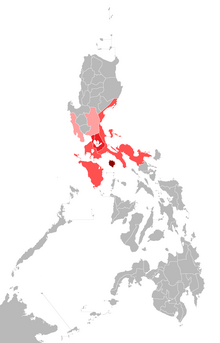Tagalog-language
| Tagalog | |
|---|---|
| Wikang Tagalog | |
| Pronunciation | [tɐˈɡaːloɡ] |
| Native to | Philippines |
| Region | Central and Southern Luzon |
| Ethnicity |
Tagalog people Filipino Americans Filipino Canadians Filipinos in Palau |
|
Native speakers
|
28 million (2007) 45 million L2 speakers (2013) Total: 70+ million (2000) |
|
Early forms
|
Proto-Philippine
|
|
Standard forms
|
|
| Dialects |
|
|
Latin (Tagalog/Filipino alphabet), Philippine Braille Historically Baybayin |
|
| Official status | |
|
Official language in
|
Regional and official in the Philippines (in the form of Filipino) |
| Regulated by | Komisyon sa Wikang Filipino |
| Language codes | |
| ISO 639-1 | tl |
| ISO 639-2 | tgl |
| ISO 639-3 |
Individual code: |
| Glottolog |
taga1280 Tagalogictaga1269 Tagalog/Filipino
|
| Linguasphere | 31-CKA |

Predominantly Tagalog-speaking regions in the Philippines. The color-schemes represent the 4 dialect zones of the language: Northern, Central, Southern, and Marinduque The majority of residents in Camarines Norte and Camarines Sur speak Bikol as their first language but these provinces nonetheless have significant Tagalog minorities. In addition, Tagalog is used as a second language across the Philippines.
|
|
Tagalog (/təˈɡɑːlɒɡ/;Tagalog pronunciation: [tɐˈɡaːloɡ]) is an Austronesian language spoken as a first language by a quarter of the population of the Philippines and as a second language by the majority. Its standardized form, officially named Filipino, is the national language of the Philippines, and is one of two official languages along with English.
It is related to other Philippine languages, such as the Bikol languages, Ilocano, the Visayan languages, Kapampangan and Pangasinan, and more distantly to other Austronesian languages, such as the Formosan languages of Taiwan, Malay (Malaysian & Indonesian), Hawaiian, Māori and Malagasy.
...
Wikipedia
